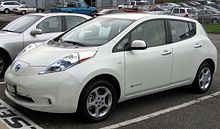A car is a wheeled, self-powered motor vehicle used for transportation and a product of the automotive industry. Most definitions of the term specify that cars are designed to run primarily on roads, to have seating for one to eight people, to typically have four wheels with tyres, and to be constructed principally for the transport of people rather than goods.[2][3] The year 1886 is regarded as the birth year of the modern car. In that year, German inventor Karl Benz built the Benz Patent-Motorwagen. Cars did not become widely available until the early 20th century. One of the first cars that was accessible to the masses was the 1908 Model T, an American car manufactured by the Ford Motor Company. Cars were rapidly adopted in the United States of America, where they replaced animal-drawn carriages and carts, but took much longer to be accepted in Western Europe and other parts of the world.
The development of external combustion engines is detailed as part of the history of the car, but often treated separately from the development of true cars. A variety of steam-powered road vehicles were used during the first part of the 19th century, including steam cars, steam buses, phaetons, and steam rollers. Sentiment against them led to the Locomotive Acts of 1865.
In November 1881, French inventor Gustave Trouvé demonstrated a working three-wheeled car powered by electricity at the International Exposition of Electricity, Paris
In 1879, Benz was granted a patent for his first engine, which had been designed in 1878. Many of his other inventions made the use of the internal combustion engine feasible for powering a vehicle. His firstMotorwagen was built in 1885 in Mannheim, Germany. He was awarded the patent for its invention as of his application on 29 January 1886 (under the auspices of his major company, Benz & Cie., which was founded in 1883). Benz began promotion of the vehicle on 3 July 1886, and about 25 Benz vehicles were sold between 1888 and 1893, when his first four-wheeler was introduced along with a model intended for affordability. They also were powered with four-stroke engines of his own design. Emile Roger of France, already producing Benz engines under license, now added the Benz car to his line of products. Because France was more open to the early cars, initially more were built and sold in France through Roger than Benz sold in Germany. In August 1888 Bertha Benz, the wife of Karl Benz, undertook the first road trip by car, to prove the road-worthiness of her husband's invention.


 The large-scale, production-line manufacturing of affordable cars was debuted by Ransom Olds in 1901 at his Oldsmobile factory located in Lansing, Michigan and based upon stationary assembly line techniques pioneered by Marc Isambard Brunel at the Portsmouth Block Mills, England, in 1802. The assembly line style of mass production and interchangeable parts had been pioneered in the U.S. by Thomas Blanchard in 1821, at the Springfield Armory in Springfield, Massachusetts.[33] This concept was greatly expanded by Henry Ford, beginning in 1913 with the world's first moving assembly line for cars at the Highland Park Ford Plant.
The large-scale, production-line manufacturing of affordable cars was debuted by Ransom Olds in 1901 at his Oldsmobile factory located in Lansing, Michigan and based upon stationary assembly line techniques pioneered by Marc Isambard Brunel at the Portsmouth Block Mills, England, in 1802. The assembly line style of mass production and interchangeable parts had been pioneered in the U.S. by Thomas Blanchard in 1821, at the Springfield Armory in Springfield, Massachusetts.[33] This concept was greatly expanded by Henry Ford, beginning in 1913 with the world's first moving assembly line for cars at the Highland Park Ford Plant.
How Envent The Car
The first working steam-powered vehicle was designed—and most likely built—by Ferdinand Verbiest, a Flemish member of a Jesuit mission in China around 1672. It was a 65-cm-long scale-model toy for the Chinese Emperor that was unable to carry a driver or a passenger.The development of external combustion engines is detailed as part of the history of the car, but often treated separately from the development of true cars. A variety of steam-powered road vehicles were used during the first part of the 19th century, including steam cars, steam buses, phaetons, and steam rollers. Sentiment against them led to the Locomotive Acts of 1865.
In November 1881, French inventor Gustave Trouvé demonstrated a working three-wheeled car powered by electricity at the International Exposition of Electricity, Paris
In 1879, Benz was granted a patent for his first engine, which had been designed in 1878. Many of his other inventions made the use of the internal combustion engine feasible for powering a vehicle. His firstMotorwagen was built in 1885 in Mannheim, Germany. He was awarded the patent for its invention as of his application on 29 January 1886 (under the auspices of his major company, Benz & Cie., which was founded in 1883). Benz began promotion of the vehicle on 3 July 1886, and about 25 Benz vehicles were sold between 1888 and 1893, when his first four-wheeler was introduced along with a model intended for affordability. They also were powered with four-stroke engines of his own design. Emile Roger of France, already producing Benz engines under license, now added the Benz car to his line of products. Because France was more open to the early cars, initially more were built and sold in France through Roger than Benz sold in Germany. In August 1888 Bertha Benz, the wife of Karl Benz, undertook the first road trip by car, to prove the road-worthiness of her husband's invention.
Production


